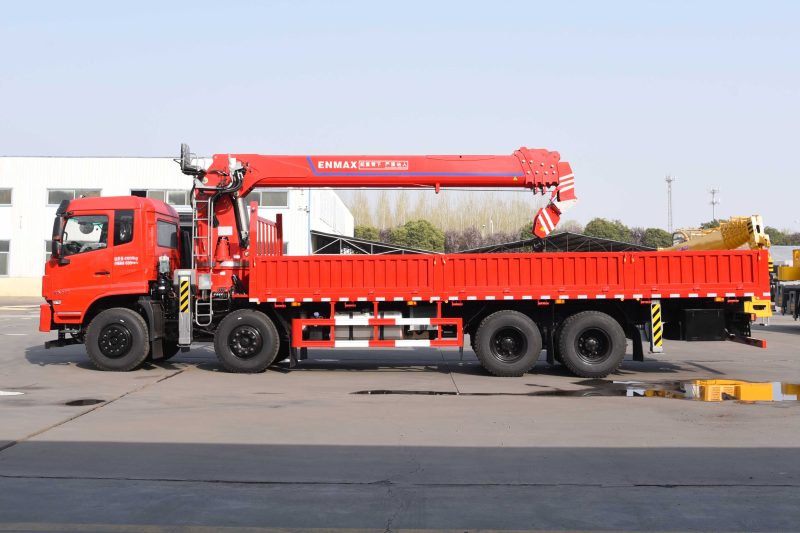Lorry-mounted cranes (LMCs), also known as truck-mounted cranes or随车吊 (suí chē diào), represent a vital fusion of transportation and material handling. These specialized vehicles integrate a hydraulic crane onto a standard truck chassis, creating a self-contained unit capable of loading, transporting, and unloading goods across diverse job sites. As industries increasingly prioritize efficiency and versatility, understanding the true capabilities and constraints of LMCs becomes essential for operational planning.
Key Advantages of Lorry-Mounted Cranes
- Enhanced Mobility and Operational Flexibility
Unlike stationary cranes or larger mobile cranes requiring specialized transport, LMCs function as standard highway vehicles. This enables rapid deployment between sites without additional hauling equipment. Their compact design allows access to urban environments, congested workspaces, or rural locations where larger cranes cannot operate efficiently. Furthermore, they often operate during urban delivery windows or night shifts where traditional trucks with separate cranes might face restrictions. - Multifunctional Capability & Cost Efficiency
LMCs eliminate the need for separate transport trucks and crane services, significantly reducing capital investment and ongoing operational expenses. Operators benefit from lower maintenance costs (single engine/vehicle system) and reduced labor costs—typically requiring only one trained operator/driver instead of separate teams. Their integrated design allows seamless switching between transport and lifting modes, maximizing equipment utilization rates. - Versatility Through Attachments and Configurations
Particularly with folding-boom cranes, LMCs can be outfitted with specialized attachments like clamshell buckets, timber grabs, personnel platforms, forklift tines, or hydraulic augers. This transforms them into multi-tool carriers capable of handling tasks ranging from log handling and scrap processing to pole setting and personnel access. Even without attachments, their core lifting function serves diverse sectors including logistics, construction, utilities, and municipal services. - Operational Simplicity and Safety
Modern LMCs feature intuitive hydraulic controls requiring comparatively shorter operator training periods versus complex all-terrain or crawler cranes. Safety systems are integral, including load moment indicators (LMIs), overload protection valves, outrigger interlock systems, and emergency stop functions. These features minimize risks during lifting operations when used within rated parameters.

Limitations and Considerations
- Site Suitability and Ground Requirements
LMCs rely on deployable outriggers/stabilizers to create a stable lifting base. This necessitates reasonably level, compact ground with adequate bearing capacity. Operations on soft, muddy, or significantly sloped terrain become hazardous and often impractical. Space constraints around the vehicle (for outrigger deployment and boom swing) can also limit functionality in extremely tight confines. - Lifting Capacity and Reach Constraints
While offering excellent versatility, LMCs cannot match the raw lifting power or height/reach capabilities of dedicated large-tonnage mobile cranes (like all-terrain or crawler cranes). Capacities diminish significantly as the boom extends or operates at wider angles. Projects requiring lifts beyond ~20 tons or heights exceeding ~18-20 meters often demand larger equipment. - Technical Complexity and Maintenance
Integrating crane hydraulics and electronics with the truck chassis adds mechanical complexity. Maintaining dual hydraulic systems (truck and crane) and ensuring structural integrity at the mounting interface requires specialized technical knowledge. Neglecting regular lubrication (pins, bearings), hose inspections, or structural checks can lead to costly downtime or failures.
Telescopic Boom vs. Folding Boom: A Critical Choice
Choosing between the two dominant LMC types hinges on specific application needs:
| Feature | Telescopic Boom | Folding Boom |
|---|---|---|
| Structure | Sections extend linearly; winch & wire rope | Articulated “knuckle” joints; pure hydraulics |
| Workspace Needed | Larger swing radius required | More compact; excels in tight spaces |
| Lift Control | Precise vertical control via wire rope | Less precise; positional via hydraulics |
| Attachments | Limited (hook block mainly) | Extensive (forks, grabs, platforms, etc.) |
| Reach/Depth | Greater reach; deep vertical access possible | Shorter max reach; excels near obstacles |
| Efficiency | Slower cycle times generally | Faster cycle times; higher productivity |
| Ease of Operation | Simpler controls | Steeper learning curve |
| Truck Integration | Easier load distribution on chassis | Concentrated loads; requires robust mounting |
| Cost | Generally lower purchase price | Higher initial investment |
- Telescopic Booms : Excel in tasks demanding vertical depth (e.g., lifting into excavations, placing pipes vertically) or longer reach on open sites. Their simpler wire-rope hoist allows smoother vertical load control. Installation on the truck chassis is often simpler due to a more distributed load profile.
- Folding Booms : Dominate in space-restricted environments (warehouses, urban streets) due to their compact stowed profile and articulated movement. Their major advantage lies in attachment versatility and typically faster work cycles, boosting productivity for repetitive tasks like container unloading or pallet handling.

Optimizing Applications
LMCs deliver exceptional value in scenarios leveraging their mobility and dual function:
- Infrastructure & Utilities: Pole setting, transformer handling, pipe laying.
- Logistics & Warehousing: Container unloading, palletized goods handling, factory internal transport.
- Landscaping & Forestry: Tree planting/removal, log loading.
- Construction Support: Delivering and placing materials (pre-cast elements, generators, machinery).
- Emergency Services: Rapid deployment for cargo recovery or disaster relief load handling.
Conclusion
Lorry-mounted cranes offer a compelling blend of transportation autonomy and on-demand lifting capability, making them indispensable tools for industries requiring frequent, dispersed material handling. While limitations exist regarding ultimate lifting capacity, site terrain dependence, and technical upkeep, their advantages in cost-efficiency, versatility, and operational agility often outweigh these constraints.
The critical decision between telescopic and folding boom configurations directly impacts productivity—choose telescopic for reach and depth, and folding for compactness, speed, and attachment versatility. By carefully matching the LMC type and specifications to the operational demands, businesses achieve significant gains in logistical efficiency and project flexibility.
Explore LMC solutions today to transform your logistics from a cost center into a competitive advantage.

